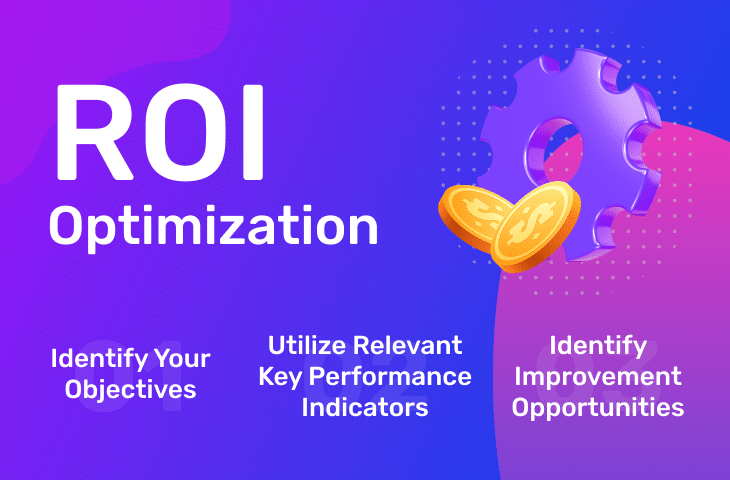What does ROI Mean in Digital Marketing?

Digital marketing involves more than focusing on buzzwords like “engagement” and “viral content.” These metrics cannot provide a clear understanding of whether the effort, money, and time you place in your digital marketing campaigns ultimately prove useful and successful. Instead, measure your digital marketing ROI.
Some important metrics that help you measure digital marketing ROI include downloads, website visitors, impressions, and brand impressions. According to OptinMonster, email marketing delivers an ROI of 4400%. Similarly, to understand how effective your online marketing efforts are, you need to track digital marketing ROI. It will help you determine if you’re making the most of your digital marketing budget.
Learn about Return On Investment (ROI)
ROI is the gain you obtain from your investment in digital marketing campaigns. It informs you if the money has been well spent and whether it has yielded tangible results.
By measuring ROI, you can learn about any gaps in your digital marketing programs and make the needed improvements to boost their effectiveness. For this purpose, you need to monitor metrics directly related to profit and revenue, such as opportunities, conversions, etc.
Digital Marketing Tools Provide Real-Time Data
Static data is not as useful as real-time data as the former only tells a part of the story. For instance, sales of a product may be less in the early morning but might improve later during the day. If you only consider either of the data, your sales strategies would not yield long-time results.
On the contrary, digital marketing tools provide you with real-time data. These solutions enable you to collect, ingest, and analyze data from a wide range of sources. As a consequence, you can use it more effectively while making informed decisions.
Let’s consider one more example here. An automobile company can target consumers looking to buy a new car with real-time data via sales and marketing campaigns. If the company has the same old data, it will never gain traction from its audience. Thus, it signifies the importance of real-time data for digital marketing.
With digital marketing tools, you can analyze customer behavioral patterns and even forecast future trends. You can also target the right customer segments by learning their preferences and needs. Moreover, this data can be useful to improve campaigns and track performance. For instance, if an initiative targeted at a young consumer group is faring poorly, you can make the necessary changes to hit the right set of people.
In a nutshell, real-time information serves as the foundation of your digital marketing strategies.
Measure Your Investment and Your Return
Measuring digital marketing ROI isn’t as simple as dividing revenue by cost. Some campaigns have goals like building awareness, attracting more buyers into the sales funnel, etc., whereas others are targeted with different objectives. Therefore, your digital marketing ROI varies depending on your campaign objectives. Here’s a list of some standard metrics highly used in digital marketing to help you track ROI efficiently.
- Cost of Each Lead
If your goal is lead generation, you should track the cost spent to gain each lead. This can be done by dividing the entire campaign or ad spend by the campaign’s total amount of leads. The revenue obtained from closing the leads should be higher than their acquisition cost to give you a positive ROI.
- Conversion Rate
This metric is ideal if your digital marketing objective is to increase conversions. A high conversion rate represents a good performance of the campaign. Hence, you can invest more resources and money to boost results.
You can measure tach sales channel’s conversion rate to find out which ones are converting the most. You can thus focus on the high-performing channels to get better returns for your investment.
Another strategy to measure conversion rates is by users’ device type. For instance, if mobile users are higher, the conversion rate is relatively less, conceptualizing more powerful mobile marketing strategies.
- Cost of Each Acquisition
This metric tells you the average cost you spend to gain a new buyer. To compute each acquisition cost, divide the total marketing cost by the number of sales generated.
If your cost per acquisition is higher than the revenue generated by sales, you’ll get a negative ROI. In this case, you need to tweak your marketing efforts and reduce the cost of each acquisition.
- Customer LTV (Lifetime Value)
Consumer LTV determines the amount of revenue an average consumer can generate for your company. This metric thus indicates the overall value of a customer for your business.
For instance, if you spend $50 to gain a customer and the buyer spends $50 every month, your $50 initial investment is worth the cost. It leads you to the long-term profits your business can avail of from potential customers.
ROI Optimization

After measuring and tracking your online marketing ROI, you can identify improvement areas and focus on them. That means, optimize your ROI. But how you do it? Well, below are a few tips to help you with ROI optimization.
- Identify Your Objectives
It is crucial to clearly understand your digital marketing goals to use the correct metrics to monitor ROI. Avoid loose goals like “increasing awareness” or “improving conversions.” Instead, ensure your objectives are measurable, specific, time-bound, relevant, and achievable.
- Utilize Relevant KPIs (Key Performance Indicators)
After defining your goals, you should select KPIs that are in alignment with the goals. You can use these KPIs to track your progress. However, SEO KPIs are different from social media or email marketing KPIs. So, be wise while you choose your KPIs. It will ultimately walk you close to your goals.
- Identify Improvement Opportunities
To boost ROI, you need to improve your campaigns based on the insights provided by the metrics you tracked.
By closely monitoring measurements, you can notice areas for improvement. Fully utilize these opportunities to enhance your campaigns. Conduct new tests continuously to find any gaps that need to be filled to improve your digital marketing programs’ effectiveness.
Wrapping Up
Measuring your digital marketing ROI is a great way to track your campaign’s success over a time period. So, you should understand your campaign’s current performance to find ways to improve it in the future. After all, higher ROI is what businesses desire the most.

